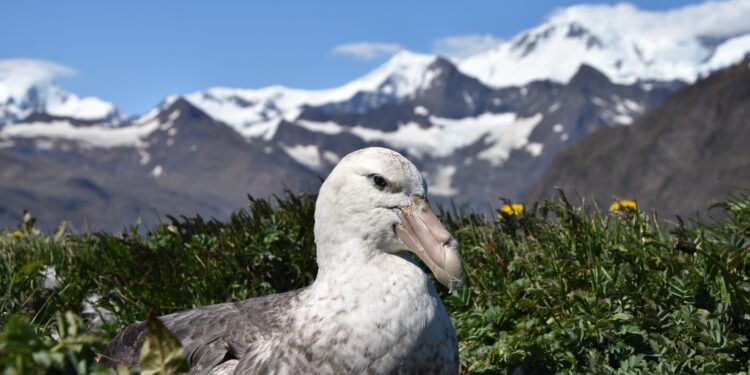Close-up of a giant petrel. Credit: Professor Richard Phillips
The rapid retreat of Antarctica’s sea ice could negatively impact the food supply of seabirds that breed hundreds of kilometres from the continent. Most of the world’s albatrosses and their close relatives, the petrels, breed on islands in the Southern Ocean, which surrounds Antarctica.
New research from Durham University in the UK and the British Antarctic Survey (BAS) has used satellite technology to track the movements of these seabirds. They have found that the birds travel huge distances to areas of the ocean affected by sea ice, known as the Antarctic Sea Ice Zone.
They are thought to travel either to feed in the nutrient-enriched waters left by the melting Antarctic ice each summer, or, in the case of southern giant petrels, to feed on seals found on the ice itself.
Until recently, Antarctica had not experienced the significant sea ice losses seen in the Arctic, but over the past five years, Antarctic sea ice has begun to retreat at a faster rate.
The results suggest that melting Antarctic sea ice could force seabirds to travel further from their breeding grounds to find food or could change their foraging habits. This in turn could affect the ecosystems that these birds are part of.
The study is published in the journal Progress in oceanography.
-
Close-up of a giant petrel. Credit: Professor Richard Phillips
-
Close-up of a wandering albatross spreading its wings. Credit: Professor Richard Phillips
-
Nesting Wandering Albatross. Credit: Professor Richard Phillips
Lead author Dr Ewan Wakefield, from Durham University’s Department of Geography, said: “Every winter the sea freezes around Antarctica, with sea ice covering tens of millions of square kilometres. We found that albatrosses and large petrels travel hundreds of kilometres, some very far into the area covered by this sea ice, and we think they do this to feed.
“In this case, the retreat of the Antarctic sea ice, caused by climate change, could affect not only the penguins, well known to many people, that breed on the continent, but also a large number of seabirds breeding hundreds or thousands of kilometers away.”
The researchers analyzed data showing the movements of seven species of albatrosses and large petrels from the sub-Antarctic island of South Georgia, located about 1,000 miles (1,600 kilometers) from Antarctica.
These species were the northern giant petrel, southern giant petrel, white-chinned petrel, pale-mantled albatross, black-browed albatross, grey-headed albatross and wandering albatross.
In total, they examined 2,497 foraging trips made by 1,289 seabirds from satellite data collected between 1992 and 2023.
They found that all seven species used parts of the ocean affected by sea ice, but in different ways.
For example, albatrosses largely avoided ice-covered areas, probably because they had difficulty flying or landing there. However, in late summer and fall, they fed in areas where the ice had melted weeks or months earlier and released concentrated nutrients into the sea.
In contrast, in the spring, southern giant petrels travel hundreds of kilometers across the pack ice, which researchers say they do to feed on seals breeding on the ice.
-
A white-chinned petrel in flight against a backdrop of icy mountains. Credit: Professor Richard Phillips
-
Close-up of a white-chinned petrel in flight. Credit: Professor Richard Phillips
On a larger scale, the researchers also discovered a remarkable pattern of birds moving from north to south with the seasons, which they believe is due to the birds following plankton blooms in the oceans, a phenomenon known as green wave surfing.
Antarctic sea ice was relatively stable during the period the satellite data were recorded, but in recent summers seasonal sea ice has retreated earlier and reached record lows.
Study co-author Professor Richard Phillips, head of the British Antarctic Survey’s Higher Predators and Conservation Group, said: “Given that all seven species of albatross and petrels we studied have visited the Antarctic seasonal sea ice zone, it is likely that they, and many other sub-Antarctic breeding seabirds, are linked to sea ice dynamics.
“The decline in Antarctic sea ice predicted under climate change could exacerbate the already unsustainable human impacts these populations are experiencing.”
The researchers said their study had some limitations. While their analysis showed that birds were using habitats affected by sea ice, they don’t know exactly what the birds were eating. They hope this will be demonstrated through monitoring and dietary studies to give a better idea of how changes in sea ice might affect different species.
The resolution of sea ice and tracking data was not sufficient to determine how birds interacted with sea ice at a fine scale, and the researchers hope that fine-scale tracking could solve this problem.
For several species, the start and end of the breeding season were not covered by monitoring, so researchers do not know how they might use sea ice habitats during this time.
The study also involved BirdLife International, the University of Barcelona, the University of Helsinki, Stony Brook University and the University of Coimbra.
More information:
Ewan D. Wakefield et al., Seasonal resource monitoring and use of sea-ice feeding habitats by albatrosses and large petrels, Progress in oceanography (2024). DOI: 10.1016/j.pocean.2024.103334
Provided by Durham University
Quote:Retreating Antarctic sea ice could impact food supply for seabirds (2024, September 12) retrieved September 12, 2024 from
This document is subject to copyright. Apart from any fair dealing for the purpose of private study or research, no part may be reproduced without written permission. The content is provided for informational purposes only.



